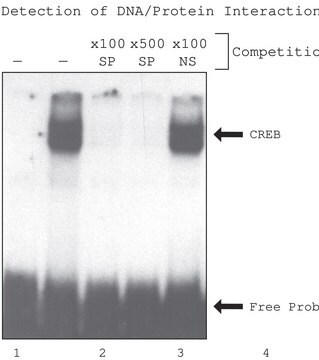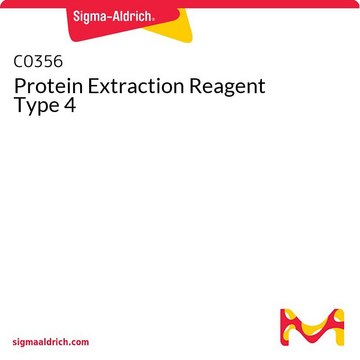P9599
Protease Inhibitor Cocktail
DMSO solution, for the inhibition of serine, cysteine, aspartic, metalloproteases and aminopeptidases, for plant cell and tissue extracts, DMSO solution
Synonym(s):
Protease Inhibitor Mix
Sign Into View Organizational & Contract Pricing
All Photos(3)
About This Item
Recommended Products
product name
Protease Inhibitor Cocktail, for plant cell and tissue extracts, DMSO solution
Quality Level
form
DMSO solution
storage temp.
−20°C
Looking for similar products? Visit Product Comparison Guide
Related Categories
General description
Our Protease Inhibitor Cocktail is a mixture of individual components optimized and tested for use with plant tissue and cell extracts. The cocktail contains a broad specificity of inhibitory properties including serine, cysteine, aspartic and metalloproteases, and aminopeptidases. The individual components include AEBSF, 1,10-Phenanthroline, Pepstatin A, Leupeptin, Bestatin, and E-64.
Specificity
Inhibits serine, cysteine, and aspartic proteases, metalloproteases, and aminopeptidases
Application
This product has been specifically tested on plant seedling extracts from pea, bean, wheat, tobacco, and Arabidopsis, as well as leaf and root extracts from pea, wheat, and tobacco. The recommended quantity is one mL of solution for the inhibition of protease activity in 100 mL of cell lysate from 30 g of various plant tissues or 10 g of baculovirus-infected cells.
Biochem/physiol Actions
This mixture contains individual components, including AEBSF, 1,10-Phenanthroline, Pepstatin A, Leupeptin, Bestatin, and E-64. Each component has specific inhibitory properties. AEBSF acts to inhibit serine proteases, including trypsin, chymotrypsin, and plasmin amongst others. Bestatin inhibits aminpeptidases. E-64 acts against cystein proteases. Leupeptin acts against both serine and cystein proteases. Pepstatin A inhibits acid proteases. 1,10-Phenanthroline acts against metalloproteases.
Features and Benefits
Contains a broad specificity of inhibitory properties including serine, cysteine, aspartic and metalloproteases, and aminopeptidases
Optimized and tested for use with plant tissue and cell extracts
Specifically tested on plant seedling extracts from pea, bean, wheat, tobacco, and Arabidopsis, as well as leaf and root extracts from pea, wheat, and tobacco
One mL of solution is recommended for the inhibition of protease activity in 100 mL of cell lysate from 30 g of various plant tissues or 10 g of baculovirus-infected cells
Optimized and tested for use with plant tissue and cell extracts
Specifically tested on plant seedling extracts from pea, bean, wheat, tobacco, and Arabidopsis, as well as leaf and root extracts from pea, wheat, and tobacco
One mL of solution is recommended for the inhibition of protease activity in 100 mL of cell lysate from 30 g of various plant tissues or 10 g of baculovirus-infected cells
Components
AEBSF
Bestatin
E-64
Leupeptin
Pepstatin A
1,10-Phenanthroline
Bestatin
E-64
Leupeptin
Pepstatin A
1,10-Phenanthroline
Caution
The cocktail should be stored at -20°C, where it will retain stability for two years.
Quantity
One mL is recommended for the inhibition of proteases extracted from 30 g of plant tissue in a total volume of 100 ml.
Preparation Note
This product is supplied as a clear, faint pink solution in DMSO. One mL of solution is recommended for inhibition of protease activity in 100 mL of cell lysate from 30 g of various plant tissues or 10 g of baculovirus-infected cells. Extracts of plant seedlings from pea, bean, wheat, tobacco, and Arabidopsis have been tested. The roots of these plants have also been successfully tested.
related product
Product No.
Description
Pricing
Storage Class Code
10 - Combustible liquids
WGK
WGK 1
Flash Point(F)
185.0 °F - closed cup
Flash Point(C)
85 °C - closed cup
Certificates of Analysis (COA)
Search for Certificates of Analysis (COA) by entering the products Lot/Batch Number. Lot and Batch Numbers can be found on a product’s label following the words ‘Lot’ or ‘Batch’.
Already Own This Product?
Find documentation for the products that you have recently purchased in the Document Library.
Customers Also Viewed
Ullrich Dubiella et al.
Proceedings of the National Academy of Sciences of the United States of America, 110(21), 8744-8749 (2013-05-08)
In animals and plants, pathogen recognition triggers the local activation of intracellular signaling that is prerequisite for mounting systemic defenses in the whole organism. We identified that Arabidopsis thaliana isoform CPK5 of the plant calcium-dependent protein kinase family becomes rapidly
Julia A Chekanova et al.
Cell, 131(7), 1340-1353 (2007-12-28)
The exosome complex plays a central and essential role in RNA metabolism. However, comprehensive studies of exosome substrates and functional analyses of its subunits are lacking. Here, we demonstrate that as opposed to yeast and metazoans the plant exosome core
Inkar Castellanos-Huerta et al.
Avian diseases, 60(4), 784-791 (2016-12-03)
Globally, avian influenza (AI) is a serious problem in poultry farming. Despite vaccination, the prevalence of AI in México highlights the need for new approaches to control AI and to reduce the economic losses associated with its occurrence in susceptible
Aurine Verkest et al.
The Plant cell, 17(6), 1723-1736 (2005-05-03)
Exit from the mitotic cell cycle and initiation of cell differentiation frequently coincides with the onset of endoreduplication, a modified cell cycle during which DNA continues to be duplicated in the absence of mitosis. Although the mitotic cell cycle and
Shugo Maekawa et al.
Frontiers in plant science, 9, 1177-1177 (2018-09-14)
The Brix domain is a conserved domain in several proteins involved in ribosome biogenesis in yeast and animals. In the Arabidopsis genome, six Brix domain-containing proteins are encoded; however, their molecular functions have not been fully characterized, as yet. Here
Our team of scientists has experience in all areas of research including Life Science, Material Science, Chemical Synthesis, Chromatography, Analytical and many others.
Contact Technical Service
















